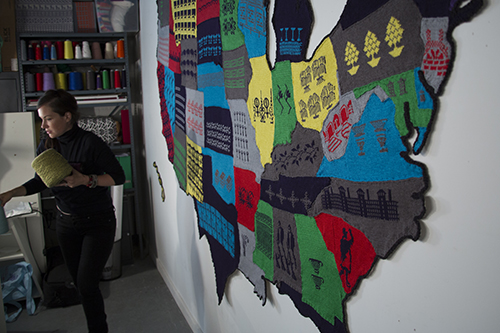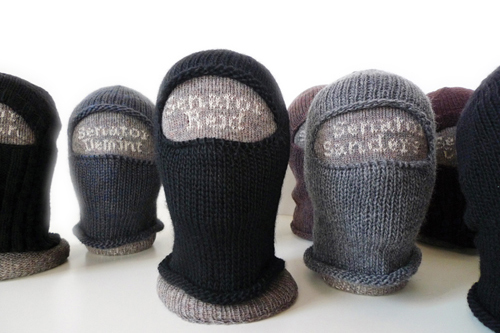art | work

Taking the Cure
Pine Wood10 x 10 x 7 feet
The Taking the Cure sculpture is a wooden structure inspired by 19th century “cure cottages” and tuberculosis (TB) treatment centers of the Massachusetts State Sanatoria. Being treated for dormant TB in the mid-2010s led to research of local histories about public health and industrial work. The sculpture was commissioned by deCordova Museum and Sculpture Park and was on view in the museum’s lakeside woods July 2018 and extended to the summer of 2020. Craft practices were a favorite porch pastime that intersected with recovery, and many sanatorium, including ones in Massachusetts had dedicated facilities to fiber, basketry, wood and small scale printing. More images and information here Cat Mazza PLATFORM. PDF of the Taking the Cure brochure written by Martina Tanga.

Labor Sister Sampler
Hand and machine knit cotton120 x 60 inches
Labor Sister Sampler 1824-1999 is a 10 foot wide knitted timeline of labor history. Fifty motifs represent key moments in the labor movement for each state. The artwork was created with the campaign initiative Artists for Hillary: Jenny Holzer, Maya Lin, Cat Mazza, Eileen Myles, Cruz Ortiz, Carrie Mae Weems and documented here. The needlework was hand and machine knitted from Nov 2015 - Aug 2016 and launched on Labor Day 2016. The patterns and history photographs are now archived on this microsite designed by Remy Hunter. Timeline in list format here.

Nike Blanket Petition
Crochet and knit; natural and synthetic yarns; web media
15 x 5.5 feet
From 2003-2008, international knit and crochet hobbyists participated in the microRevolt project the Nike Blanket Petition, a 15-foot wide handmade blanket of the Nike swoosh. Each 4 x 4 inch acts as a signature for fair labor policies for Nike garment workers. Over the five-year period, "anti-sweatshop" squares were stitched into the quilt-- representing people petitioning from over 30 countries. Squares accumulated from microRevolt workshops and exhibition tours, though many were donated from global knitting circles by post-mail. The Nike Blanket has been on view at the Musée Bargoin (Clermont-Ferrand, France); the Victoria and Albert Museum (London); the Museum of Contemporary Craft (Portland); the Museum of Design (Atlanta) the Textile Museum of Canada (Toronto) among other venues. Link.

microRevolt video
Documentation of microRevolt | social practiceSince 2003.
This video documents the workshops, performances and activism of microRevolt, which connect craft, technology and labor activism. The project started to investigate the dawn of sweatshops in early industrial capitalism to inform the current crisis of global expansion and the feminization of labor. Mostly shot on DV tape in the mid-2000s, the footage was taken on tours to various knitting circles, art or activist spaces. Projects highlighted include knitPro and the Nike Blanket Petition. Co-editted by Penny Lane. Soundtrack by Suzanne Thorpe. video link.

Stitch for Senate
100 Hand and Machine Knit balaclavas
10 x 12 x 10/each
Stitch for Senate was a pro-peace initiative of knit hobbyists making helmet liners for every United States senator in the lead up to the 2008 election. Building on the history of wartime knitting, a practice dating back to the American Revolution, Stitch for Senate used the tradition of political organizing within knitting circles as a space for discussion, skillsharing and protest. Hobbyists knitted to persuade elected officials to support the troops by bringing them home. Every senator received their own helmet liner, mailed on President Obama's Inaguration. Of the 100 senators who received the headwear, Bernie Sanders (VT), Harry Reid (NV), Russ Feingold (WI), Orrin Hatch (UT) Jim DeMint (SC), Byron Dorgan (ND), Michael Enzi (WY), John Cornyn (TX), Daniel Inouye (HI) & James Inhofe (OK) and Tom Udall (NM) sent replies.

Knit for Defense
Moving Image, 9:00 min
Smithsonian American Art Museum collection
Support from Creative Capital
Knit for Defense is an animation at the intersection of craft, labor and combat, exploring the aesthetics of war in film in an animation of knit stitches. Knit for Defense is created from archival footage and historical artifacts, sounds from knitting machines and textile processes, threading together footage from World War II, Vietnam and the wars in Iraq and Afghanistan, when wartime knitting was in practice. Knit motifs of tanks, planes, ships and drones animate a cinema of combat, reflecting on war from a pixelated distance. Sound design: Jesse Stiles. Renwick Gallery exhibition video.

Electroknit Series No-One
Hand and machine knit cotton12 x 16 inches each
The Electroknit Series are machine knitted textile compositions based on global textile patterns that spread virally in a pre-digital era. Patterns circulated from generation to generation through grid notebooks, manuscripts, needlecraft magazines and by transcribing designs from textile objects. These grid based motifs continue to circulate globally as a decorative language with pre-industrial roots. Sometimes patterns are identical even though they are made in remote locations on different continents. The patterns sampled in the Electroknit Series span from an early printed pattern book from the year 1523 to contemporary patterns made with knitPro in 2015. Artwork commissioned by Franklin Street Works for the exhibition Artists Make Spaces.
